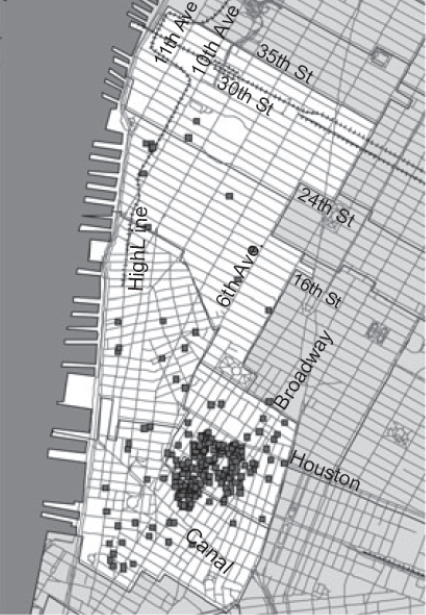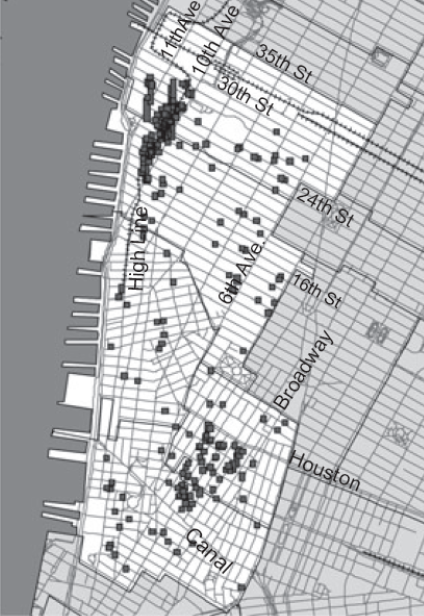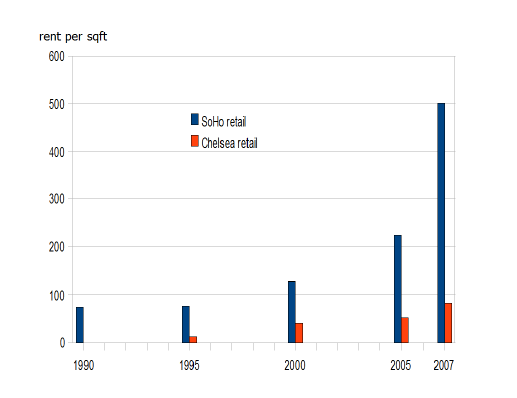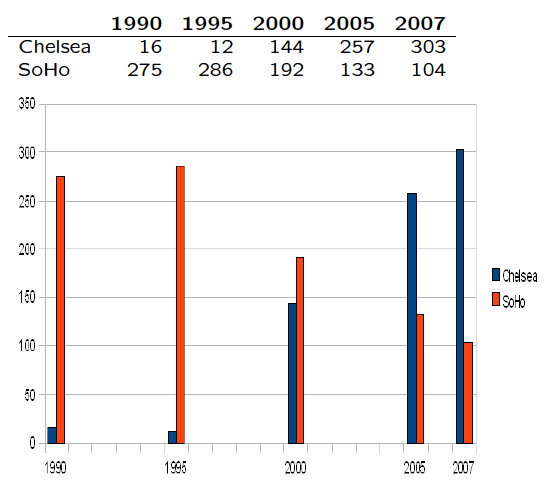Distribution of Galleries in Manhattan (1995) Distribution of Galleries in Manhattan (2007)
The areas Chelsea and Soho in New York City are most famous for the sale of contemporary art. They have the largest number of galleries of any city in the world. Chelsea and Soho are considered “transient gallery locations” while Midtown is a “stable gallery location” therefore Midtown has not been included in my response as it appeals to a different audience and excludes contemporary art.
After 1995 Chelsea developed as the central area for artists forced to leave SoHo because of rent prices. As SoHo gentrified, rent increased, there was large in flux of wealthy people who could pay the increasingly expensive rents, thus kicking the struggling artists out. The “affordability squeeze" was a cause for galleries to move to Chelsea. Gentrification does not only depend on rents but also on prices of the products being sold. As the Molotoch and Trekson document illustrates, rent was not the sole reason for the move to Chelsea. As the local art scene in SoHo began to fade and the area was not longer a “curious bohemia” (518). As the artists moved, many gallery owners decided to move as well.
Cost of Rent per sq ft in Chelsea and Soho over a 17 year period. SoHo rent increased a huge amount as the area became gentrified and a tourist hot spot.
- When considering a location for a gallery important things to consider are:
- An Attractive location: to which kind of audience?
- Affordable location: how much is it worth to pay?
- How large should the space be?
- Suitable location: does it fit to the art to be sold?
- Distance to competitors/collaborators?
Chelsea was more affordable for artists & gallerists, it allowed galleries to have larger spaces and the new location fit with the new up and coming contemporary art movement. In Chelsea there are many boutique style galleries which also cater to a different kind of audience. The boutique galleries in Chelsea act as museums without entrance fees, therefore they are accessible to a much larger audience. Even the audience that comes into the gallery knowing they won’t by anything is affective promotion for the smaller galleries as there is a word of mouth factor. Many galleries located in Chelsea are more, quaint and small compared to Opera Gallery, still located in SoHo, which caters to a very "show boat" kind of buyer who enjoys name brand art and is likely investing in art for the social aspect and the price tags bragging rights.
The number of galleries in Chelsea and SoHo over a 17 year period.
In terms of the future of galleries in Manhattan i believe overtime galleries will migrate from Chelsea just as they did SoHo. Galleries like to follow the artists, however; galleries change the economic value of the district. Galleries tend to cause gentrification by turning cultural into economic capital. Galleries spur social and economic revitalization. Often artists cannot keep up with the environment the galleries create, thus artists move and galleries once again eventually follow. This trend is already evident in the establishment of galleries in Williamsburg, Brooklyn. Williamsburg is known as the newest artist hang out. I believe galleries will see the environment artists are creating in Williamsburg and want to capitalize on the movement. As the Molotoch and Trekson document illustrates the local art scene is important for galleries to thrive. Chelsea has become gentrified and is no longer an area where struggling artists can live, i believe the SoHo- Chelsea cycle will continue.



